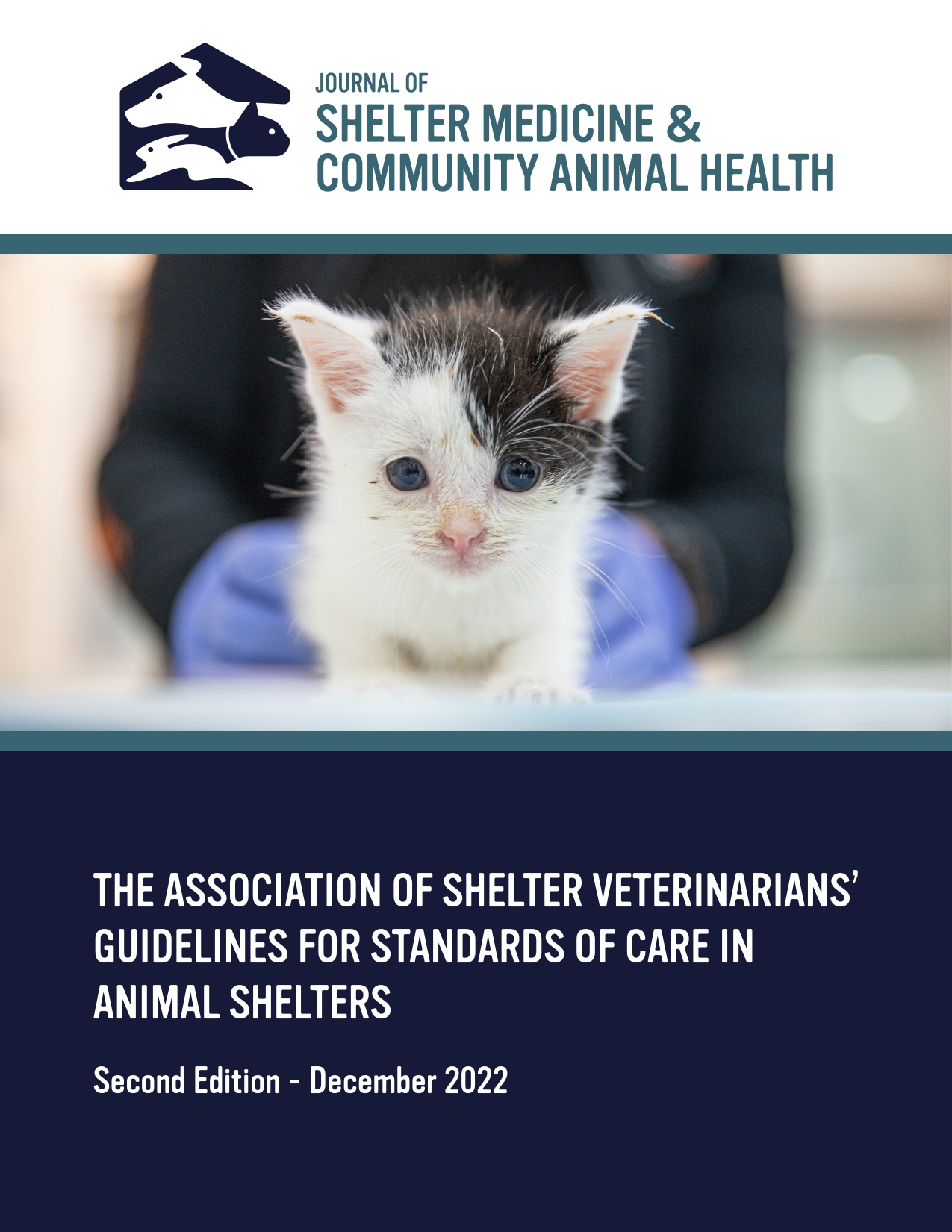Trap–Neuter–Return and Return-to-Field Programs for Managing Community Cats at Florida Animal Shelters
DOI:
https://doi.org/10.56771/jsmcah.v4.126Keywords:
spay, neuter, animal shelter, community cats, feline welfare, shelter medicine, animal shelter outcomes, trap-neuter-return, return-to-fieldAbstract
Introduction: The purpose of this study was to determine the extent to which Florida shelters utilize community cat programs for traditional trap–neuter–return (TNR), in which the original intent was to return the cat to its neighborhood following spay/neuter and return-to-field (RTF), in which return to the neighborhood was deemed the most appropriate outcome after a cat’s admission to the shelter as a free-roaming stray.
Methods: Florida animal shelters admitting 200 or more cats in 2019 were surveyed on practices related to the management of community cats. Results were correlated with cat admission and outcome data and rural versus urban locations.
Results: Surveys were received from 110 of the 116 animal shelters admitting 200 or more cats in 2019 (95% response rate), of which 58 shelters (53%) performed TNR (55 shelters; 50%) and/or RTF (33; 30%). Shelter-based programs were available in 31 of 35 (89%) urban counties surveyed compared to only seven of 21 (33%) rural counties where cat shelter admissions and euthanasia rates were higher (P < 0.0001). TNR/RTF programs were more common in shelters admitting higher numbers of cats and reporting higher live outcome rates for cats. Shelters commonly collaborated with other organizations and volunteers to carry out the programs, including for transporting cats to and from the field, performing spay/neuter surgery, and funding surgery costs. TNR/RTF programs provided rabies vaccination (100% of TNR and RTF programs), feline panleukopenia virus, herpesvirus and calicivirus vaccination (80% TNR; 88% RTF), FeLV testing (44% TNR; 41% RTF), FIV testing (43% TNR; 41% RTF), internal parasite control (56% TNR; 84% RTF), external parasite control (76% TNR; 88% RTF), treatment of illnesses/injuries (91% TNR; 97% RTF), and humane euthanasia (85% TNR; 88% RTF).
Conclusion: Shelters using the option of TNR and/or RTF programs for community cats had higher live outcome rates for cats than shelters without such programs. Expansion of shelter-based TNR/RTF programs in conjunction with community-based programs to support pet retention and to increase access to veterinary care are opportunities to reduce unnecessary admission and euthanasia of cats in shelters and deaths of kittens born in the wild. Regional collaborations between urban organizations where programs are well established and supported by community engagement could be expanded to support neighboring rural communities where resources are scarce, thereby creating a statewide safety net, not only for community cats but for all cats and dogs.
Downloads
References
1.
American Society for the Prevention of Cruelty to Animals. Pet Statistics. Accessed Dec 29, 2019. https://www.aspca.org/animal-homelessness/shelter-intake-and-surrender/pet-statistics
2.
Chu K, Anderson WM, Rieser MY. Population Characteristics and Neuter Status of Cats Living in Households in the United States. J Am Vet Med Assoc. 2009;234(8):1023–1030. doi: 10.2460/javma.234.8.1023
3.
Hurley KF, Levy JK. Rethinking the Animal Shelter’s Role in Free-Roaming Cat Management. Front Vet Sci. 2022;9:847081. doi: 10.3389/fvets.2022.847081
4.
Janeczko S. Community Cats. In: White S, ed. High-Quality, High-Volume Spay and Neuter and Other Shelter Surgeries. Wiley-Blackwell; 2020:477–508.
5.
Slater M, Weiss E. Sterilization Programs and Population Control. In: White S, ed. High-Quality, High-Volume Spay and Neuter and Other Shelter Surgeries. Wiley-Blackwell; 2020:455–476.
6.
Rowan AN. Companion Animal Statistics in the USA. In: Demography and Statistics for Companion Animal Populations Collection. 2018:7. Accessed Apr 27, 2025. https://www.wellbeingintlstudiesrepository.org/cgi/viewcontent.cgi?article=1002&context=demscapop.
7.
Centonze LA, Levy JK. Characteristics of Free-Roaming Cats and Their Caretakers. J Am Vet Med Assoc. 2002;220(11):1627–1633. doi: 10.2460/javma.2002.220.1627
8.
Levy JK, Woods JE, Turick SL, Etheridge DL. Number of Unowned Free-Roaming Cats in a College Community in the Southern United States and Characteristics of Community Residents Who Feed Them. J Am Vet Med Assoc. 2003;223(2):202–205.
9.
Dalrymple AM, Stively NE, Kreisler R. Tag! You’re Home! Reunification of Pet Cats With Their Owners Using a Community Engagement Approach: A Community Case Report. J Shelter Med Community Anim Health. 2025;3(1):1–8. doi: 10.56771/jsmcah.v3.113
10.
Neal SN, Kremer T. Who Cares? Exploring the Demographics and Proportion of People Providing Care for Community Cats in Seven Study Communities in the United States. J Shelter Med Community Anim Health. 2024;3(1):1–13. doi: 10.56771/jsmcah.v3.71
11.
Save Lives with Feral Freedom: A Guide to the Feral Freedom Program. 2010. Accessed Jan 1, 2025. https://fcnmhp.org/wp-content/uploads/2013/11/FeralFreedomGuide.pdf
12.
Spehar DD, Wolf PJ. The Impact of an Integrated Program of Return-to-Field and Targeted Trap-Neuter-Return on Feline Intake and Euthanasia at a Municipal Animal Shelter. Animals (Basel). 2018;8(4):1–14. doi: 10.3390/ani8040055
13.
Spehar DD, Wolf PJ. Integrated Return-To-Field and Targeted Trap-Neuter-Vaccinate-Return Programs Result in Reductions of Feline Intake and Euthanasia at Six Municipal Animal Shelters. Front Vet Sci. 2019;6:77. doi: 10.3389/fvets.2019.00077
14.
Spehar DD, Wolf PJ. The Impact of Return-to-Field and Targeted Trap-Neuter-Return on Feline Intake and Euthanasia at a Municipal Animal Shelter in Jefferson County, Kentucky. Animals (Basel). 2020;10(8):1–18. doi: 10.3390/ani10081395
15.
Johnson KL, Cicerelli J. Study of the Effect on Shelter Cat Intakes and Euthanasia from a Shelter Neuter Return Project of 10,080 Cats from March 2010 to June 2014. Peer J. 2014;2:1–17. doi: 10.7717/peerj.646
16.
Huang L, Coradini M, Rand J, et al. Search Methods Used to Locate Missing Cats and Locations Where Missing Cats Are Found. Animals (Basel). 2018;8(1):1–20. doi: 10.3390/ani8010005
17.
Edinboro CH, Watson HN, Fairbrother A. Association Between a Shelter-Neuter-Return Program and Cat Health at a Large Municipal Animal Shelter. J Am Vet Med Assoc. 2016;248(3):298–308. doi: 10.2460/javma.248.3.298
18.
Wilford C. Feral and Free-Roaming Cat Clinics. In: White S, ed. High-Quality, High-Volume Spay and Neuter and Other Shelter Surgeries. Wiley-Blackwell; 2020:615–626.
19.
Dalrymple AM, MacDonald LJ, Kreisler RE. Ear-Tipping Practices for Identification of Cats Sterilized in Trap-Neuter-Return Programs in the USA. J Feline Med Surg. 2022;24(10):e302–e309. doi: 10.1177/1098612X221105843
20.
Mielo MR, Amirian ES, Levy JK. Identification of Spayed and Neutered Cats and Dogs: Veterinary Training and Compliance With Practice Guidelines. Vet J. 2022;285:105856. doi: 10.1016/j.tvjl.2022.105856
21.
Spehar DD, Wolf PJ. A Case Study in Citizen Science: The Effectiveness of a Trap-Neuter-Return Program in a Chicago Neighborhood. Animals (Basel). 2018;8(1):1–15. doi: 10.3390/ani8010014
22.
Spehar DD, Wolf PJ. Back to School: An Updated Evaluation of the Effectiveness of a Long-Term Trap-Neuter-Return Program on a University’s Free-Roaming Cat Population. Animals (Basel). 2019;9(10):1–14. doi: 10.3390/ani9100768
23.
Spehar DD, Wolf PJ. The Impact of Targeted Trap-Neuter-Return Efforts in the San Francisco Bay Area. Animals (Basel). 2020;10(11):1–12. doi: 10.3390/ani10112089
24.
Kreisler RE, Cornell HN, Levy JK. Decrease in Population and Increase in Welfare of Community Cats in a Twenty-Three Year Trap-Neuter-Return Program in Key Largo, FL: The ORCAT Program. Front Vet Sci. 2019;6:7. doi: 10.3389/fvets.2019.00007
25.
Benka VA, Boone JD, Miller PS, et al. Guidance for Management of Free-Roaming Community Cats: A Bioeconomic Analysis. J Feline Med Surg. 2022;24(10):975–985. doi: 10.1177/1098612X211055685
26.
Boone JD, Miller PS, Briggs JR, et al. A Long-Term Lens: Cumulative Impacts of Free-Roaming Cat Management Strategy and Intensity on Preventable Cat Mortalities. Front Vet Sci. 2019;6:238. doi: 10.3389/fvets.2019.00238
27.
Levy JK, Gale DW, Gale LA. Evaluation of the Effect of a Long-Term Trap-Neuter-Return and Adoption Program on a Free-Roaming Cat Population. J Am Vet Med Assoc. 2003;222(1):42–46.
28.
Hughes KL, Slater MR, Haller L. The Effects of Implementing a Feral Cat Spay/Neuter Program in a Florida County Animal Control Service. J Appl Anim Welf Sci. 2002;5(4):285–298. doi: 10.1207/S15327604JAWS0504_03
29.
Levy JK, Isaza NM, Scott KC. Effect of High-Impact Targeted Trap-Neuter-Return and Adoption of Community Cats on Cat Intake to a Shelter. Vet J. 2014;201(3):269–274. doi: 10.1016/j.tvjl.2014.05.001
30.
Florida Shelter Animal Census. Accessed Apr 26, 2025. https://sheltermedicine.vetmed.ufl.edu/research/current-studies/florida-animal-sheltering/
31.
Neal SM, Greenberg MJ. Veterinary Care Deserts: What Is the Capacity and Where Is It? J Shelter Med Community Anim Health. 2022;1(1):1–8. doi: 10.56771/jsmcah.v1.2
32.
Neal SM, Greenberg MJ. Putting Access to Veterinary Care on the Map: A Veterinary Care Accessibility Index. Front Vet Sci. 2022;9:857644. doi: 10.3389/fvets.2022.857644
33.
The Veterinary Care Accessibility Score: County Level VAS. Accessed Jan 24, 2025. https://www.accesstovetcare.org/vcas-map
34.
Wald DM, Jacobson SK, Levy JK. Outdoor Cats: Identifying Differences between Stakeholder Beliefs, Perceived Impacts, Risk and Management. Biological Conservation. 2013;167:414–424. doi: 10.1016/j.biocon.2013.07.034
35.
McDonald JL, Farnworth MJ, Clements J. Integrating Trap-Neuter-Return Campaigns Into a Social Framework: Developing Long-Term Positive Behavior Change Toward Unowned Cats in Urban Areas. Front Vet Sci. 2018;5:258. doi: 10.3389/fvets.2018.00258
36.
McDonald JL, Clements J. Engaging with Socio-Economically Disadvantaged Communities and Their Cats: Human Behaviour Change for Animal and Human Benefit. Animals (Basel). 2019;9(4):1–11. doi: 10.3390/ani9040175
37.
Chu K, Anderson WM. U.S. Public Opinion on Humane Treatment of Stray Cats. 2007:1–6. Law and Policy Brief. Accessed Apr 27, 2025. https://www.alleycat.org/wp-content/uploads/2014/12/ACA-USPublicOpinionPoll.pdf
38.
Janeczko S. Prevalence of, Risk Factors for, and Zoonotic Potential of Giardia Spp. Infection in Cats Housed in an Animal Shelter. J Vet Intern Med. 2009;23:717.
39.
Lord LK, Wittum TE, Ferketich AK, Funk JA, Rajala-Schultz PJ. Search and Identification Methods that Owners Use to Find a Lost Cat. J Am Vet Med Assoc. 2007;230(2):217–220. doi: 10.2460/javma.230.2.217
40.
Weiss E, Slater M, Lord L. Frequency of Lost Dogs and Cats in the United States and the Methods Used to Locate Them. Animals (Basel). 2012;2(2):301–315. doi: 10.3390/ani2020301
41.
Lord LK. Attitudes Toward and Perceptions of Free-Roaming Cats among Individuals Living in Ohio. J Am Vet Med Assoc. 2008;232(8):1159–1167. doi: 10.2460/javma.232.8.1159
42.
Neal SM, Wolf P. A Cat Is a Cat: Attachment to Community Cats Transcends Ownership Status. J Shelter Med Community Anim Health. 2023;2(2):1–9. doi: 10.56771/jsmcah.v2.62
43.
DiGangi BA, Graves J, Budke CM, Levy JK, Tucker S, Isaza N. Assessment of Body Weight for Age Determination in Kittens. J Feline Med Surg. 2020;22(4):322–328. doi: 10.1177/1098612X19844846
44.
Nutter FB, Levine JF, Stoskopf MK. Reproductive Capacity of Free-Roaming Domestic Cats and Kitten Survival Rate. J Am Vet Med Assoc. 2004;225(9):1399–1402.
45.
Schmidt PM, Lopes LR, Collier BA. Survival, Fecundity, and Movements of Free-Roaming Cats. J Wildlife Management. 2007;71(3):915–919. doi: 10.2193/2006-066
46.
The Cat Superhighway: The Right Outcome for Every Cat. Accessed Jan 24, 2025. https://sheltermedicine.vetmed.ufl.edu/shelter-services/the-right-outcome/the-community-cat-superhighway/
47.
Griffin B, Bohling MW, Brestle K. Tattoo and Ear-Tipping Techniques for Identification of Surgically Sterilized Dogs and Cats. In: White S, ed. High-Quality, High-Volume Spay and Neuter and Other Shelter Surgeries. Wiley-Blackwell; 2020:325–338.
48.
Fischer SM, Quest CM, Dubovi EJ, et al. Response of Feral Cats to Vaccination at the Time of Neutering. J Am Vet Med Assoc. 2007;230(1):52–58. doi: 10.2460/javma.230.1.52
49.
Dezubiria P, Amirian ES, Spera K, Crawford PC, Levy JK. Animal Shelter Management of Feline Leukemia Virus and Feline Immunodeficiency Virus Infections in Cats. Front Vet Sci. 2022;9:1003388. doi: 10.3389/fvets.2022.1003388
50.
Little S, Levy J, Hartmann K, et al. 2020 AAFP Feline Retrovirus Testing and Management Guidelines. JFMS Clinical Practice. 2020;22:5–30.
51.
Scott KC, Levy JK, Crawford PC. Characteristics of Free-Roaming Cats Evaluated in a Trap-Neuter-Return Program. J Am Vet Med Assoc. 2002;221(8):1136–1138.
52.
Wallace JL, Levy JK. Population Characteristics of Feral Cats Admitted to Seven Trap-Neuter-Return Programs in the United States. J Feline Med Surg. 2006;8(4):279–284. doi: 10.1016/j.jfms.2006.02.004
53.
Guerios S, Houston K, Oglesby M, Farinha M, Jenkins M. When You Cannot Put That Cat Back Where It Came From – The Call for a ‘Working Cat Program’ Implementation. J Shelter Med Community Anim Health. 2024;3(1):1–7. doi: 10.56771/jsmcah.v3.89
54.
MuniCode Codification: Florida. CivicPlus. Accessed Jan 24, 2025. https://library.municode.com/fl
55.
Intake & Outcome Datacase. Accessed Jan 24, 2025. https://www.shelteranimalscount.org/wp-content/uploads/2025/01/SAC_IntakeandOutcomeDatabase_IOD_012325.pdf

Additional Files
Published
Issue
Section
License
Copyright (c) 2025 Cassidy A. Schiefer, Keegan Spera, P. Cynda Crawford, Julie K. Levy

This work is licensed under a Creative Commons Attribution 4.0 International License.









